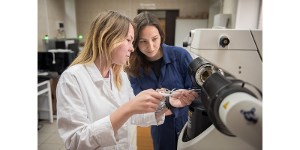Scientists at the TSU Laboratory of Physics of High-Strength Crystals, SPhTI, under a joint grant of the Russian Science Foundation and the German Research Foundation (DFG), have developed a new alloy with shape memory. Its functional characteristics surpass those of titanium nickelide, the leader among materials capable of restoring their shape when heated after high external loads. This development is promising for creating innovative solutions in the aviation, aerospace, automotive, and robotics industries.
The SPhTI scientists created, for the first time, single crystals of iron-based alloys (iron-nickel-cobalt-aluminum) with a replaceable fifth element – titanium and/or niobium. The new materials are able to compete with alloys of nickel-titanium, the most popular and sought-after compound used to create medical instruments, implants, actuators, thermal sensors, and other structures.
New iron-based alloys are more reversible than titanium nickelide, that is, the ability to recover after deformation (shape memory effect). In iron-based alloys, a reversible change in shape reaches 15%, but in nickel-titanium alloys, it is about 10%. Due to this, the sensors and actuators of iron-based alloys will work more efficiently, as will the mechanisms that they set in motion.


